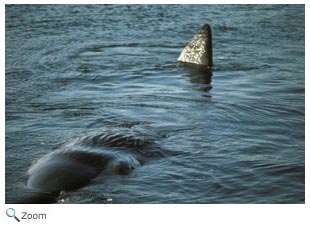Physeteridae - sperm whales
 There are three species of toothed whales in this family, the
sperm whale, the pygmy sperm whale, and the dwarf sperm whale. There are three species of toothed whales in this family, the
sperm whale, the pygmy sperm whale, and the dwarf sperm whale.
Sperm whales get their name from the
spermaceti organin their heads. The spermaceti organ produces an oil that used to be valuable to whale hunters. The oil was used to make candles. Scientists don't really know how sperm whales use the spermaceti organ.
Sperm whales are found in all of the world's oceans, except for the Arctic. They eat fish and squid.
The sperm whale is 30-60 feet in length. It has a huge, square head that can be up to 20 feet long! It has a single blow hole and small flippers. It doesn't have a dorsal fin, but it has a hump on its back.
The pygmy sperm whale is 10-14 feet long and weighs up to 900 pounds. It has a small dorsal fin; small, rounded flippers; and a square head. It is found in temperate and tropical waters around the world. It eats fish, squid, octopus, and crustaceans.
The dwarf sperm whale is the smallest whale. it is around nine feet in length and weighs around 500 pounds. It look like the pygmy sperm whale, but it is smaller and has a larger dorsal fin. It is found in temperate and tropical waters around the world. It eats fish, squid, octopus, and crustaceans. World Status Key
 Least Concern Least Concern  Near Threatened Near Threatened  Vulnerable Vulnerable  Endangered Endangered  Critically Endangered Critically Endangered  Extinct in Wild Extinct in Wild  Extinct Extinct
Status and range is taken from ICUN Redlist. If no status is listed, there is not enough data to establish status.
US Status Key
 Threatened in US Threatened in US  Threatened in NH Threatened in NH  Endangered in US Endangered in US  Endangered in NH Endangered in NH  Introduced Introduced
Status taken from US Fish and Wildlife and NH Fish and Game
New Hampshire Species |
|
North/Central American Species |
| None |
|
Pygmy Sperm Whale - Kogia breviceps
Dwarf Sperm Whale - Kogia sima
Sperm Whale - Physeter macrocephalus  |
Additional Information Resource Key
 Profile Profile  Photos Photos  Video Video  Audio Audio
Dwarf Sperm Whale - Kogia sima          
The dwarf sperm whale is found world-wide in offshore waters of tropical and warm temperate zones.
Source: Arkive Intended Audience: Students Reading Level: Middle School
Dwarf Sperm Whale - Kogia sima           
The dwarf sperm whale is around eight to nine feet in length and weighs between 300-600 pounds.
Source: Convention on Migratory Species Intended Audience: Students Reading Level: High School
Dwarf Sperm Whale - Kogia sima           
The dwarf sperm whale can eject over 3 gallons of a dark liquid liquid when it feels threatened or when it is trying to evade predators.
Source: NOAA Fisheries Intended Audience: Students Reading Level: Middle School
Dwarf Sperm Whale - Kogia sima           
Dwarf sperm whales are usually seen over the continental shelf and slope.
Source: Animal Diversity Web Intended Audience: Students Reading Level: Middle School
Dwarf Sperm Whale - Kogia sima           
The dwarf sperm whale has a dorsal fin that looks like the dorsal fin of a bottlenose dolphin.
Source: Smithsonian Museum of Natural History Intended Audience: Students Reading Level: Middle School Pygmy Sperm Whale - Kogia breviceps          
Pygmy sperm whales are found in deep waters in tropical to warm temperate zones of all oceans.
Source: Arkive Intended Audience: Students Reading Level: Middle School
Pygmy Sperm Whale - Kogia breviceps           
Pygmy sperm whales are around 10-14 feet in length and weigh around 900 pounds.
Source: American Cetacean Society Intended Audience: Students Reading Level: Middle School
Pygmy Sperm Whale - Kogia breviceps           
Like the dwarf sperm whale, the pygmy sperm whale uses an ink-like liquid to evade and deter predators.
Source: NOAA Fisheries Intended Audience: Students Reading Level: Middle School
Pygmy Sperm Whale - Kogia breviceps           
The pygmy sperm whale's diet includes squid, shrimp, and fish.
Source: Convention on Migratory Species Intended Audience: Students Reading Level: High School
Pygmy Sperm Whale - Kogia breviceps           
The pygmy sperm whale usually travels in small pods of 3-6 individuals.
Source: Animal Diversity Web Intended Audience: Students Reading Level: Middle School
Pygmy Sperm Whale - Kogia breviceps           
The pygmy sperm whale sometimes mistakes floating plastic bags for squid.
Source: Smithsonian Museum of Natural History Intended Audience: Students Reading Level: Middle School
Sperm Whale - Physeter macrocephalus               
The sperm whale is found in deep waters in oceans around the world.
Source: Arkive Intended Audience: General Reading Level: Middle School
Sperm Whale - Physeter macrocephalus               
The sperm whale can swim to depths of two miles.
Source: Animal Diversity Web Intended Audience: General Reading Level: Middle School Sperm Whale - Physeter macrocephalus               
Sperm whales are the largest toothed whales.
Source: Enchanted Learning Intended Audience: Students Reading Level: Elementary School
Sperm Whale - Physeter macrocephalus               
Adult female sperm whales can be up to 36 feet in length; males can be up to 52 feet in length - that's longer than a school bus!
Source: NOAA Fisheries Intended Audience: General Reading Level: Middle School Sperm Whale - Physeter macrocephalus               
Sperm whales have the largest brain of any creature known to have lived on Earth.
Source: National Geographic Intended Audience: General Reading Level: Middle School
Sperm Whale - Physeter macrocephalus              
The fictional Moby Dick was a sperm whale.
Source: American Cetacean Society Intended Audience: Students Reading Level: Middle School
Sperm Whale - Physeter macrocephalus               
The sperm whale can stay under water for up to 90 minutes.
Source: Smithsonian Museum of Natural History Intended Audience: Students Reading Level: Middle School |

